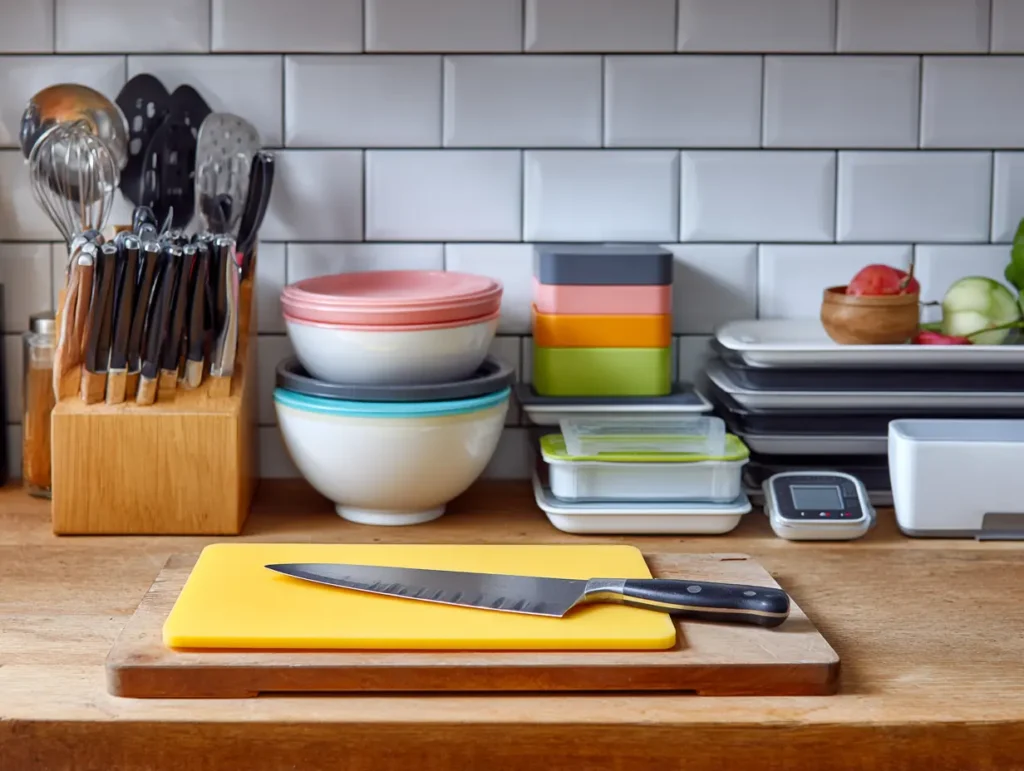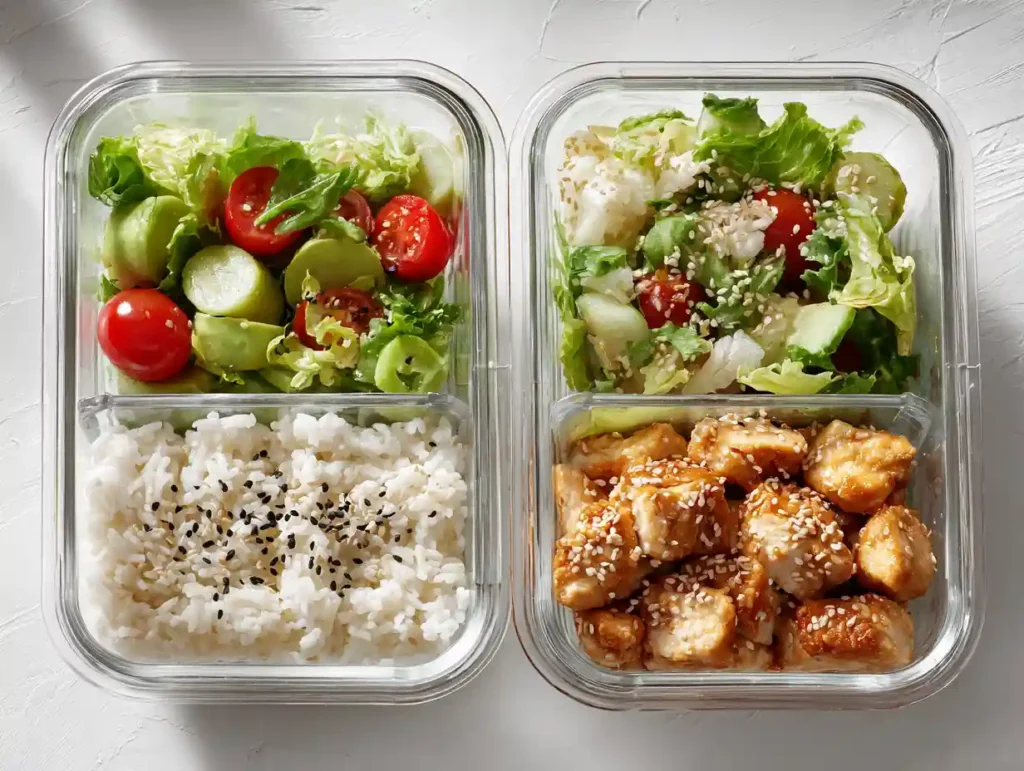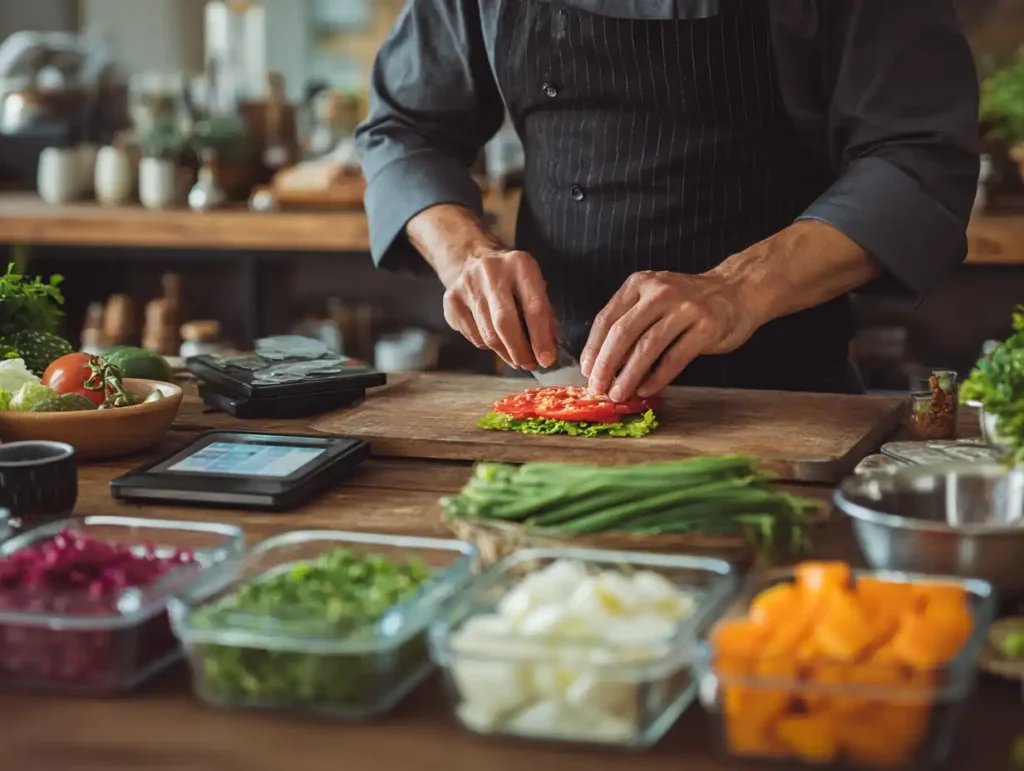If you’re searching for meal prep tools, you’re probably looking to simplify your cooking routine, save time during busy weeks, or finally get organized in the kitchen. This article breaks down the exact tools, from basic utensils to time-saving gadgets, that can make meal prepping faster, easier, and even enjoyable. Whether you’re prepping for a family, a fitness plan, or just trying to eat healthier, you’ll find the essentials you need right here.

I still remember the first time I committed to weekly meal prepping. I had a couple of plastic containers, a dull knife, and zero plan. Within a week, I was overwhelmed cutting vegetables took forever, food spoiled, and I felt like I spent more time cleaning than cooking. That changed the moment I invested in a few smart kitchen tools: a good chef’s knife, a set of glass containers, and a digital scale. These weren’t just upgrades, they transformed how I cook. If you’re tired of chaotic kitchen sessions, you’re in the right place.
Jump To
Types of Meal Prep Tools
Whether you’re just starting out or looking to upgrade your routine, understanding the different types of meal prep tools is key to building an efficient kitchen setup. From everyday essentials to time-saving gadgets and specialized gear, each tool plays a role in helping you prep faster, store smarter, and stay consistent with your meals.
Essential Kitchen Tools for Meal Prep
These are the must-have kitchen tools for meal prep reliable items that form the core of any successful setup. They don’t require electricity or apps, just good design and durability.
Basic Tools Every Prepper Needs:
- Chef’s knife: for efficient chopping and slicing
- Cutting board: wood or BPA-free plastic, ideally non-slip
- Measuring cups and spoons: for accuracy in portions and recipes
- Digital kitchen scale: essential for portion control and macros
- Mixing bowls: nesting sets save space and suit batch prep
- Silicone spatula: heat-resistant and perfect for scraping sauces
- Grater or microplane: great for cheese, zest, and garlic
- Mandoline slicer: for quick, uniform slicing of vegetables
Pro tip: Invest in stainless steel and dishwasher-safe materials for durability and convenience.
Time-Saving Meal Prep Gadgets
Smart gadgets save time, effort, and cleanup. These meal prep gadgets are especially useful for prepping in bulk or on tight schedules.
Top Meal Prep Gadgets
| Gadget | What It’s Best For | Why It Helps |
|---|---|---|
| Instant Pot | Cooking grains, beans, stews fast | Combines pressure cooker, slow cooker, steamer in one |
| Air fryer | Crisping veggies, reheating leftovers | Faster than oven, uses less oil |
| Rice cooker | Flawless rice or quinoa with no supervision | Frees up stovetop and attention |
| Egg cooker | Boiling multiple eggs at once | Great for high-protein batch prep |
| Food processor | Chopping, slicing, grating | Saves manual knife work |
| Slow cooker | Set-and-forget bulk meals overnight | Ideal for soups, shredded proteins |
These kitchen gadgets to meal prep with aren’t required, but once you start using them, it’s hard to go back.
Meal Prep Containers and Storage Solutions
While we cover containers in depth in a separate article, here’s what you need to know to get started. The right containers aren’t just storage, they’re part of your meal prep tools system.

Glass vs Plastic: A Quick Comparison
| Feature | Glass Containers | Plastic Containers |
|---|---|---|
| Microwave Safe | Yes | Yes |
| Oven Safe | Yes | No |
| Durability | High (non-staining) | Moderate (prone to scratching) |
| Weight | Heavier | Lightweight |
| Cost | Higher upfront | More budget-friendly |
Containers with compartments help keep meals organized, especially for lunches or portion-controlled diets. Stackable designs save fridge and freezer space a must if you’re prepping in bulk. For deeper guidance, explore our full article on the best meal prep containers.
Specialized Tools for Different Needs
Not all prep looks the same, and there are meal prep supplies tailored to specific goals.
For Parents
- Toddler-sized containers
- Bento boxes
- Mini cutters for fun shapes
- Easy-grip utensils
(See our full article on toddler meal prep tools.)
For Fitness and Bulk Prep
- Portion scoops and macro scales
- Freezer-safe trays
- Vacuum sealers for protein storage
- Large-capacity blenders and cookers
For Large-Scale Food Prep
- Industrial mixing bowls
- High-volume food processors
- Labeling systems for inventory tracking
You don’t need everything on day one, just the tools that match your current goals and scale.
Where to Buy Affordable Meal Prep Equipment
Finding the right meal prep tools doesn’t mean spending a fortune. There are many reputable retailers, both in-store and online, that offer quality meal prep equipment, containers, and accessories at prices that suit different budgets and cooking styles.

The key is knowing where to shop based on your needs, whether you’re stocking up for a large family or just starting out with the basics.
Top Places to Shop for Meal Prep Equipment
1. Costco
Costco is a go-to for bulk buying and large-scale food prep. You’ll find high-capacity mixing bowls, glass container sets, and even countertop appliances like Instant Pots at competitive prices. For those prepping meals for multiple people, Costco’s large packs of meal prep containers and durable best kitchen tools offer strong value.
2. Amazon
Amazon remains one of the most convenient platforms for finding affordable and well-reviewed meal prep accessories. You can compare brands, check user reviews, and often get same- or next-day delivery. It’s also a good source for specialty gadgets like egg cookers, mandoline slicers, or stackable container systems.
3. Walmart and Target
Both stores offer accessible pricing on meal prep beginner-friendly kitchen tools like cutting boards, silicone spatulas, measuring cups, and storage containers. Their private-label brands often provide excellent value, and in-store shopping allows you to evaluate product quality before buying.
4. Specialty Retailers (e.g., Bed Bath & Beyond, Sur La Table)
If you’re looking for longer-lasting or premium tools, like stainless steel knives, high-end food processors, or branded glassware, kitchen specialty retailers carry curated selections. They may cost more upfront, but often last longer with proper care.
5. Local Discount Stores
Stores like TJ Maxx, HomeGoods, or Marshalls occasionally carry quality branded tools at reduced prices. While inventory varies, they’re great for scoring deals on meal prep tools like storage jars, lunch bags, or prep kits.
Tips for Buying Smart
- Look for bundled sets (e.g., containers + utensils) to save more per item.
- Prioritize multi-use tools (e.g., a food processor that also slices and grates).
- Check material quality (BPA-free plastics, stainless steel, oven-safe glass).
- Read reviews for durability, especially for tools used frequently.
You don’t need to buy everything at once. Start with what supports your routine now, then build your toolkit over time as your needs evolve.
Choosing the Best Meal Prep Tools for Your Routine
Not all meal prep tools are right for everyone. The best setup depends on your lifestyle, dietary habits, kitchen size, and how much food you prepare at once. Instead of chasing the most expensive gear or copying someone else’s list, it’s better to think strategically: What tools will save you time, reduce stress, and fit how you actually cook?
Factors to Consider When Choosing Meal Prep Equipment
1. Your Meal Prep Goals
Are you prepping lunches for work? Managing a family’s weekly meals? Following a specific diet like keto, plant-based, or high-protein?
- A parent might prioritize stackable containers and snack-size portions.
- A fitness-focused prepper may need a food scale, portion scoops, or macro-friendly containers.
- If you batch-cook full meals, large pots, sheet pans, or a slow cooker might be essential.
2. Frequency and Volume
How often you prep and how much, affects what tools matter most.
- For daily prep, tools that save time (like an Instant Pot or air fryer) are worth it.
- For weekly batch cooking, go for durable containers, industrial mixing bowls, and storage space.
3. Storage Space and Kitchen Layout
Overcrowding your kitchen with gear you rarely use will slow you down.
- If space is limited, prioritize multi-function tools and stackable storage.
- Labeling systems and vertical storage can also help organize your flow, see our article on kitchen organization tips for meal prep.
Examples of Best Tools for Different Users
| User Type | Must-Have Tools |
|---|---|
| Busy professional | Meal prep containers, air fryer, insulated lunch bag |
| Parent with toddlers | Toddler-friendly containers, small portion tools |
| Fitness-focused | Digital scale, portion scoops, macro containers |
| Minimalist | Sharp knife, cutting board, silicone spatula |
| Large batch cook | Slow cooker, sheet pans, bulk storage containers |
The best approach is to build your collection gradually. Start with the essentials for meal prepping, then invest in higher-end tools that align with your routine. What matters most is how your tools support your habits, not just how many you own.
Expert Tips from Dietitians and Chefs
Even with the right meal prep tools, it’s the small habits and techniques that make prep routines sustainable over time.

To help you go beyond the basics, we’ve gathered practical advice from culinary professionals and registered dietitians who regularly use these tools in real-world settings.
1. Start with Tools That Match Your Meals
Chef instructors at the Culinary Institute of America recommend building your toolkit based on what you actually cook most often. “If you’re roasting vegetables weekly, invest in good sheet pans. If you eat a lot of grain bowls, a rice cooker and quality knives make all the difference,” says Chef Monica Patel, a prep instructor at CIA.
2. Don’t Overlook Workflow
According to a report by the Academy of Nutrition and Dietetics, organizing your cooking station can cut prep time by up to 30%. Dietitians often use clear containers with labels, prep trays, and mise en place setups to streamline the cooking flow and reduce food waste. This is where meal prep gadgets like nesting bowls or prep carts can add functional value.
3. Make Your Tools Visible and Accessible
Chef Alan Kim, who runs batch-cooking workshops in Seattle, advises home cooks to keep frequently used tools, like knives, peelers, scales, and measuring cups, visible and within arm’s reach. “If a tool is buried in a drawer, it doesn’t exist. Hang utensils, use magnetic knife strips, or open shelving.”
4. Choose Quality Over Quantity
Rather than buying trendy meal prep tools that only serve one purpose, experienced chefs prefer versatile, durable tools. “You don’t need 50 kitchen items, just the right 10,” says Kim. Look for BPA-free, stainless steel, dishwasher-safe, or heat-resistant materials when purchasing essential meal prep tools.
5. Use Prep Time to Plan Nutrition
Registered dietitians emphasize that meal prep isn’t just about saving time, it’s also an opportunity to control portions, balance macros, and reduce processed food intake. Using a digital kitchen scale, portion scoops, or compartment containers can help structure meals more intentionally.
If you’re just starting out, choose your meal prep tools that align with your personal health goals. If you’re already meal prepping, refining your system with expert-backed habits can make it more consistent, sustainable, and even enjoyable.
Common Mistakes When Buying Meal Prep Tools
Having the right meal prep tools can completely change the way you cook, but only if you choose wisely. Many people make purchasing decisions based on trends or aesthetics, then end up with cluttered drawers and unused gadgets. Avoiding common mistakes from the start can save you money, time, and frustration in the long run.
1. Buying Too Much, Too Soon
It’s easy to get excited and buy every tool that claims to “save time.” But if you’re just starting out, stick to the essential meal prep tools first, like a sharp knife, measuring tools, and durable containers. Build your collection slowly as your routine develops. Overbuying often leads to underusing.
2. Choosing Cheap Materials That Don’t Last
Low-cost doesn’t always mean value. Plastic containers that warp in the dishwasher or knives that dull quickly are false bargains. Instead, look for BPA-free, stainless steel, heat-safe silicone, and oven-safe glass. These materials last longer and support safe, efficient cooking.
3. Prioritizing Looks Over Functionality
Instagram-worthy tools may look appealing, but function always comes first. Avoid trendy items that serve only one purpose unless they fill a specific gap in your routine. Reliable meal prep gadgets should be versatile, easy to clean, and durable enough for regular use.
4. Ignoring Your Actual Prep Style
A person who batch-cooks full meals will need different tools than someone who preps snacks or individual ingredients. Buying a spiralizer makes no sense if you never prep zucchini noodles. Before purchasing, ask: “Do I already cook this way, and will this tool make it easier?”
5. Overlooking Storage and Organization
Too many tools without a plan for storage can slow you down. Large gadgets like food processors or air fryers need dedicated counter or cabinet space. Consider how you’ll organize your kitchen for meal prep, and leave room for future additions.
6. Skipping Reviews and Product Research
Before buying any tool especially online, check for detailed reviews that speak to durability, ease of cleaning, and performance. Brands can look impressive but fall short in real use. User reviews often highlight real-world pros and cons that specs don’t reveal.
Being selective and intentional with your purchases leads to a more functional kitchen, not a cluttered one. The goal isn’t to collect tools, it’s to build a meal prep system that truly works for your routine.
FAQ
How far in advance can you safely meal prep?
Most meals can be safely prepped 3 to 5 days in advance, depending on storage. Use airtight containers, refrigerate promptly, and freeze meals if prepping for the full week.
What is a common mistake people make when meal planning?
Planning too many new or complex meals at once. It’s better to start with familiar recipes and tools that match your actual cooking habits.
What are the cons of meal prep?
Meal prep can lead to food fatigue, storage challenges, and loss of freshness. It also requires a few hours of upfront time each week.
Conclusion
Building the right collection of meal prep tools changed everything for me. I used to dread Sunday nights, piles of dishes, last-minute cooking, and meals that didn’t hold up. But once I found the tools that actually fit my routine, it all clicked. Now, prepping feels less like a chore and more like something I genuinely enjoy. It saves me time, keeps me eating better, and gives me one less thing to stress about during the week.
I love this process because it brings calm to my kitchen and structure to my life. Having the right tools on hand makes it easier to stick to my goals, waste less food, and cook with confidence. Whether you’re just getting started or refining your system, I hope this guide helps you build a toolkit that truly works for you.
